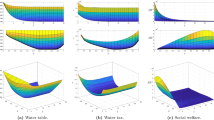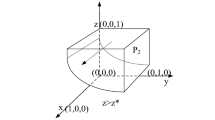Abstract
This paper studies how to counter the illegal exploitation of common groundwater resource in an evolutionary game approach. The access is not free and firms have to pay a royalty depending on the quantity of water pumped. However, some firms could decide to not pay the royalty and face the risk of being sanctioned by the regulator authority. The overall sanction is composed of a fixed amount and of the royalty not payed. From the analysis of the model it emerges that coexistence at the equilibrium between compliant and non-compliant firms is possible and policy instruments are partially able to counter the unauthorized exploitation. In particular, increasing the sanction level reduces the number of non-compliant firms but raises the incidence of illegal pumping. The opposite occurs if the regulatory authority increases the royalty price. To pursue both goals, applying a balance of policies is necessary.







Similar content being viewed by others
Notes
Conference on “Water & Agriculture” Events at Mercure Hotel, Boulevard de Lauzelle 61, Louvain-La-Nueve (Belgium), September 2010.
Although a water linear demand is not the most favorable functional form, it nevertheless simplifies the analysis of the model and for this reason it is widely used in literature.
In Sect. 4 we relax this assumption assuming \(\rho \) function of water pumped by both types of firms.
Another possibility to represent probability (4) is to model it as a function of the water table, that is the difference between the effective water level and the one compatible with compliant pumping. Also in this case, the probability of being discovered discovered, \(\phi \), will be a function of the share of non-compliant firms. Therefore, we prefer to represent it as (4), for obvious reasons of tractability, following Petrohilos-Andrianos and Xepapadeas (2017).
In all simulations, we change \(\sigma \) from 100 to 900, while \(\delta \) from 0.0007 to 0.0013. Both intervals are such that the inner steady state (\(x^\star ,H^\star \)) exists.
All the new functions will be denoted with symbol \('\).
References
Agnew, D. J., Pearce, J., Pramod, G., Peatman, T., Watson, R., Beddington, J. R., & Pitcher, T. J. (2009). Estimating the worldwide extent of illegal fishing. PloS ONE, 4(2), e4570.
Antoci, A., Borghesi, S., & Sodini, M. (2017). Water resource use and competition in an evolutionary model. Water Resources Management, 31(8), 2523–2543.
Biancardi, M., & Maddalena, L. (2018). Competition and cooperation in the exploitation of the groundwater resource. Decisions in Economics and Finance, 41(2), 219–237.
Bomze, I. M., & van Damme, E. E. (1992). A dynamical characterization of evolutionarily stable states. Annals of Operations Research, 37, 229–244.
Budds, J. (2009). Contested H2O: science, policy and politics in water resources management in Chile. Geoforum, 40(3), 418–430.
Confederacio Hidrografica del Guadiana. (2005). Plan especial del Alto Guadiana. Madrid, Spain: Borrador Documento de Directrices.
Cressman, R. (2003). Evolutionary Dynamics and Extensive Form Games. Cambridge, MA, USA: MIT Press.
De Stefano, L., & Lopez-Gunn, E. (2012). Unauthorized groundwater use: institutional, social and ethical considerations. Water Policy, 14(S1), 147–160.
Dworak, T., Schmidt, G., De Stefano, L., Palacios, E., Berglund, E., 2010. Background paper to the conference: Application of EU water-related policies at farm level.
Esteban, E., & Albiac, J. (2011). Groundwater and ecosystems damages: questioning the Gisser-Sánchez effect. Ecological Economics, 70(11), 2062–2069.
Friedman, D. (1991). Evolutionary games in economics. Econometrica, 59(3), 637–666.
Gisser, M., & Sanchez, D. A. (1980). Competition versus optimal control in groundwater pumping. Water Resources Research, 16(4), 638–642.
Hingu, D., Rao, K. M., & Shaiju, A. (2018). On superiority and weak stability of population states in evolutionary games. Annals of Operations Research, 287, 751–760.
Hofbauer, J., & Sigmund, K. (2003). Evolutionary game dynamics. Bulletin of the American Mathematical Society, 40(4), 479–519.
Kim, C., Moore, M. R., Hanchar, J. J., & Nieswiadomy, M. (1989). A dynamic model of adaptation to resource depletion: theory and an application to groundwater mining. Journal of Environmental Economics and Management, 17(1), 66–82.
Koundouri, P. (2004). Current issues in the economics of groundwater resource management. Journal of Economic Surveys, 18(5), 703–740.
Koundouri, P., & Christou, C. (2006). Dynamic adaptation to resource scarcity and backstop availability: theory and application to groundwater. Australian Journal of Agricultural and Resource Economics, 50(2), 227–245.
Martínez-Santos, P., Llamas, M. R., & Martínez-Alfaro, P. E. (2008). Vulnerability assessment of groundwater resources: a modelling-based approach to the Mancha Occidental aquifer. Spain. Environmental Modelling and Software, 23(9), 1145–1162.
Negri, D. H. (1989). The common property aquifer as a differential game. Water Resources Research, 25(1), 9–15.
Ostrom, E. (1990). Governing the Commons: the Evolution of Institutions for Collective Action. Cambridge, UK: Cambridge University Press.
Palmer, C. (2001). The extent and causes of illegal logging: an analysis of a major cause of tropical deforestation in Indonesia. Centre for Social and Economic Research on the Global Environment: London, UK.
Petrohilos-Andrianos, Y., & Xepapadeas, A. (2017). Resource harvesting regulation and enforcement: an evolutionary approach. Research in Economics, 71(2), 236–253.
Provencher, B., & Burt, O. (1993). The externalities associated with the common property exploitation of groundwater. Journal of Environmental Economics and Management, 24(2), 139–158.
Rubio, S. J., & Casino, B. (2001). Competitive versus efficient extraction of a common property resource: the groundwater case. Journal of Economic Dynamics and Control, 25(8), 1117–1137.
Rubio, S. J., & Casino, B. (2003). Strategic behavior and efficiency in the common property extraction of groundwater. Environmental and Resource Economics, 26(1), 73–87.
United Nations Development Programme. (2006). Human Development Report 2006: Beyond Scarcity - Power. Poverty and the Global Water Crisis. Palgrave Macmillan: Basingstoke, UK.
Weibull, J. W. (1995). Evolutionary Game Theory. Cambridge, MA, USA: MIT Press.
World Wide Fund, 2006. Illegal water use in Spain: causes, effects and solutions.
Xepapadeas, A. (2005). Regulation and evolution of compliance in common pool resources. Scandinavian Journal of Economics, 107(3), 583–599.
Acknowledgements
We would like to thank the two anonymous reviewers whose comments and suggestions helped improve and clarify an earlier version of this manuscript.
Author information
Authors and Affiliations
Corresponding author
Additional information
Publisher's Note
Springer Nature remains neutral with regard to jurisdictional claims in published maps and institutional affiliations.
Rights and permissions
About this article
Cite this article
Biancardi, M., Iannucci, G. & Villani, G. An evolutionary game on compliant and non-compliant firms in groundwater exploitation. Ann Oper Res 318, 831–847 (2022). https://doi.org/10.1007/s10479-021-04297-5
Accepted:
Published:
Issue Date:
DOI: https://doi.org/10.1007/s10479-021-04297-5




